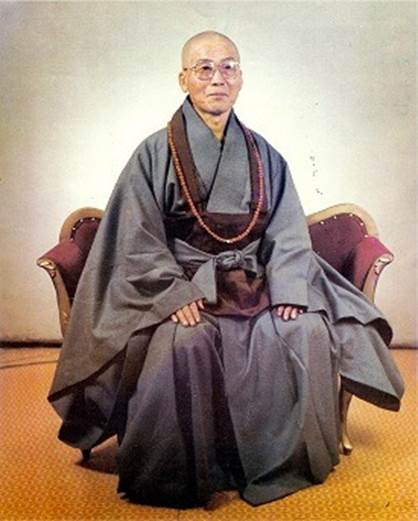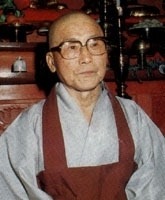ZEN MESTEREK ZEN MASTERS
« Zen főoldal
« vissza a Terebess Online nyitólapjára

서경보 / 徐京保 Seo Gyeongbo (1914-1996)
aka 일붕 / 一鵬 Il-Bung

https://blog.daum.net/philook/15721237
Ven. Dr. Kyungbo-Seo (Il-Bung)
Master Seo Kyung-bo Sunim (Oct. 10, 1914 ~ June 25, 1996)
Water-Moon Monastery
Half-day, I put aside the zen stick
and sit in the hall.
Wind harmonizes, people quite,
my mind pure and clear.
Pure tea fills the bowl, zen mind enjoys.
Vegetables piled on the table
taste spring fresh.
What is Zen?
“Willows are green and flowers are red.
Flowers are red and yet not red,
willows are green and yet not green,
now again, willows are green, flowers are red.
There is nothing so close as the teaching of “Suchness,”
a grain of sand contains all land and sea.
When we have found the Truth,
mountain is mountain, water is water,
willows are green, flowers are red,
One is all, all in all, I am Universe, Buddha is I.”
Water and Mountain
Il Bung sits at the Zen gate,
water, mountain, and white clouds appear.
Warm sun, and cool breeze. What scenery!
Birds sing, and flowers smile- quite a peaceful spring.
Spirits and humans listen to my dharma
Spirits and humans bend their ear to my dharma.
Flower petals fall like rain and cover the earth.
Bending down, I see the dragon palace, a silver world beneath the sea.
Lying down, I see the moon cave in the sky, like a jeweled tower.
Blue tiger, raven-black dragon
Blue tiger, raven-black dragon midnight roar.
Rivers and mountains all radiate great light.
For a thousand years, sun and moon appear in my palm.
Wind and clouds carry me for a thousand miles.
Il Bung's mind and eye
Il Bung's mind-eye, great and without obstacle.
Vast ocean, endless sky-moonlight bathes my chest.
The vast ocean, empty and clear, is Il Bung's eye.
The endless sky, quiet and wide, is Il Bung's mind.
Seo Kyung-Bo, A Study of Korean Zen Buddhism Approached through the Chodangjip
Seoul: Poryŏn’gak, 1973
PDF: Turning the Wheel of Dharma in the West: Korean Son Buddhism in North America
by Samu Sunim (Kim, Sam-Woo)
pp. 235-241.
In: Korean Americans and their religions : pilgrims and missionaries from a different shore
edited by Ho-Youn Kwon, Kwang Chung Kim, and R. Stephen Warner. 2001. Chapter 13: pp. 227-258.

The Il Bung Zen Order or "Il Bung Son Jong Hoe"
(一鵬禪宗會/일붕선종회)
https://ilbung.weebly.com/about.html
The Il Bung Zen Order carries the name of it's founder, the Most Venerable Il Bung (the monastic name of Dr. Seo Kyung Bo). Il Bung roughly means "One Well Winged", the first character literally translating as "one" (in it's adjective form carrying the connotation of that which is singularly great, or ultimate) and the second being derived from a transliteration of the Sanskrit word "suparṇa", which is a reference to a great, golden winged Buddhist mythological bird creature known as a "Peng" in Chinese, or in Sanskrit, a "Garuda". A typical Chinese dictionary definition for "Peng" (鵬) is "a fabulous bird of enormous size", which certainly is a fitting description of our Order's founder.
The Most Venerable Il Bung (Kyung Bo Seo) was born in 1914 and lived a very full life to the age of 82, during which he penned some 700 books, and was awarded more than 100 doctorate degrees from Universities around the world (earning his first degree in 1962, and his first Western Ph.D from Temple University in Philadelphia with the dissertation "A Study of Korean Zen Buddhism Approached Through the Chodangjip" in 1969). Most Venerable Il Bung lived life with a degree of concentration, intention and productivity that few have even aspired to, always practicing, studying, and teaching the dharma wherever he went, a trait that he encouraged and inspired in his students.
The Birth of an Order:
Our Order was founded in 1975, eleven years after the Most Venerable Il Bung first came to the United States (in 1964) as the first teacher of Korean Zen Buddhism to the west. The Order initially served to simply unite the Most Venerable Il Bung's teaching efforts (which had by then stretched not only the whole of the United States, but also reached far across the globe), however it took on a distinct identity in by 1988 when our founder decided to part organizational ways with the Korean Buddhist Chogye Order.
The Il Bung Zen Order places emphasis on both scholastic study (kyo) and Zen practice (seon), noting that our founder was both a Zen Master and a Tripitaka Master. In particular, the Most Venerable Dr. Il Bung stressed the importance of the teachings of Korean Masters Bojo Jinul and Hyujeong (Sosan Daesa) (noting that he published an English translation of Jinul's "Chinsim Chiksol" entitled "Master Bojo's Zen Teaching"). Indeed, all of the Most Venerable Il Bung's ordained Western disciples had completed extensive training and study in the wider Buddhist tradition, readily were mature in their spiritual development, and well read across the spectrum of Eastern Philosophy, which allowed him to help many of them to 'finish their work' as it were, with his keen eyed Zen teaching. And, as a true Zen Master, our Dr. Seo made wide use of most any type of non-verbal teaching one could fathom, from silent seated and walking meditation, to advanced forms of yogic and danjun (abdominal breathing) exercises, Buddhist martial arts, and one-on-one, eye-to-eye dharma exchange (dokchom), whilst making skillful use of words (Zen question and answer dialogue) when necessary.
As an Order, we uphold in all forms of Zen practice that may appear between our teachers and disciples, the necessity of the presence of three gems that our founder taught as requirements for the study of Zen, that is, the need for 1.) A Zen Master, 2.) A Zen Temple and 3.) Spiritual friends.
Il Bung Zen Society
The Il Bung Zen Society was founded by Zen Master Don Gilbert (1909–2006), also known as Ta Hui. In 1968, he was initiated into the Chogye Order of Korean Zen Buddhism by Seo Kyung-bo (1914–1996), one of the first Korean Zen teachers who settled in the United States. In 1973, Gilbert was named Kyung-bo’s dharma heir. Gilbert held services in three widely separated temples in Arcata and Carmel, California, and Huntsville, Alabama. He authored two cartoon books on Zen whose featured characters are a bloodhound and a canine Zen master.
Sources
PDF: Gilbert, Don. Jellyfish Bones: The Humor of Zen. Oakland, CA: Blue Dragon Press, 1980.
Gilbert, Don. The Upside Down Circle: Zen Laughter. Nevada City, CA: Blue Dolphin, 1988.
Dharma Lineage of Buddha's Direct Transmission
(佛祖正傳法脈)
1st Patriarch Ven. Mahakashyapa (摩訶迦葉)
|
2nd Patriarch Ven. Ananda (阿難尊者)
|
3rd Patriarch Ven. Sanavasa (商那和修)
|
4th Patriarch Ven. Upagupta (優波鞠多)
|
5th Patriarch Ven. Dhritaka (提多迦)
|
6th Patriarch Ven. Micchaka (彌遮迦)
|
7th Patriarch Ven. Vasumitra (婆須密多)
|
8th Patriarch Ven. Buddhanandi (佛陀難提)
|
9th Patriarch Ven. Buddhamitra (伏馱密多)
|
10th Patriarch Ven. Parsiva (脇尊者)
|
11th Patriarch Ven. Punyayasas (富那夜奢)
|
12th Patriarch Ven. Asvagosha (馬鳴大師)
|
13th Patriarch Ven. Kapimala (迦毘摩羅)
|
14th Patriarch Ven. Nagarjuna (龍樹大師)
|
15th Patriarch Ven. Kanadeva (迦那提婆)
|
16th Patriarch Ven. Rahulata (羅喉羅多)
|
17th Patriarch Ven. Sanghanandi (僧伽難提)
|
18th Patriarch Ven. Gayasata (伽倻舍多)
|
19th Patriarch Ven. Kumarata (鳩摩羅多)
|
20th Patriarch Ven. Sayata (闍夜多)
|
21st Patriarch Ven. Vasubandhu (婆修盤頭)
|
22nd Patriarch Ven. Manorahita (摩拏羅)
|
23rd Patriarch Ven. Haklenayasa (鶴勒那)
|
24th Patriarch Ven. Simhabodhi (師者尊者)
|
25th Patriarch Ven. Vasi Asita (婆舍斯多)
|
26th Patriarch Ven. Puyamitra (不如密多)
|
27th Patriarch Ven. Prajnatara (般若多羅)
Chinese Patriarchs (中國祖師)
28th Patriarch Ven. Bodhidharma (菩提達磨)
|
29th Patriarch Ven. Huike (二祖慧可)
|
30th Patriarch Ven. Sengcan (三祖僧璨)
|
31st Patriarch Ven. Daoxin (四祖道信)
|
32nd Patriarch Ven. Hongren (五祖弘忍)
|
33rd Patriarch Ven. Huineng (六祖慧能)
|
34th Patriarch Ven. Nanyue Huairang (南嶽懷讓)
|
35th Patriarch Ven. Mazu Daoyi (馬祖道一)
|
36th Patriarch Ven. Xītáng Zhìzàng (西堂智藏)
Korean Patriarchs (韓國祖師)
37th Patriarch Ven. Wŏnjŏk Toŭi (元寂道義)
|
38th Patriarch Ven. Ŏksung Yŏmgŏ (億聖廉居)
|
39th Patriarch Ven. Pojo Ch'ejing (普照體澄)
|
40th Patriarch Ven. Sŏngak Hyŏngmi (先覺逈微)
|
41st Patriarch Ven. Muwi Dosu (無爲道修)
|
42nd Patriarch Ven. Hyekong Chŏngyŏl (慧空定悅)
|
43rd Patriarch Ven. Wŏlsan Kyŏngmyŏng (月山景明)
|
44th Patriarch Ven. Inkak Chahŭl (麟角自屹)
|
45th Patriarch Ven. Porim Iik (寶林爾益)
|
46th Patriarch Ven. Chisan Hyean (智山慧安)
|
47th Patriarch Ven. Hyangsu Hyeham (香水惠含)
|
48th Patriarch Ven. Wŏnŭng Hakil (圓應學一)
|
49th Patriarch Ven. Hongwŏn Tot'ae (弘圓道泰)
|
50th Patriarch Ven. Kwisan Haean (龜山海安)
|
51st Patriarch Ven. Chinchŏn Taeung (陳田大雄)
|
52nd Patriarch Ven. Pokak Ilyŏn (普覺一然)
|
53rd Patriarch Ven. Pokam Honku (寶鑑混丘)
|
54th Patriarch Ven. Chinchŏng Ch'ŏngchin (真靜清珍)
|
55th Patriarch Ven. Hoeŏm Kwangchi (檜儼廣智)
|
56th Patriarch Ven. T’aego Pou (太古普愚)
|
57th Patriarch Ven. Hwanam Honsu (幻庵混修)
|
58th Patriarch Ven. Gugok Gakhun (龜谷覺雲)
|
59th Patriarch Ven. Pyŏkkye Chŏngsim (碧溪淨心)
|
60th Patriarch Ven. Pyŏksong Chiŏm (碧松智嚴)
|
61st Patriarch Ven. Puyong Yŏnggwan (芙蓉靈觀)
|
62nd Patriarch Ven. Ch'ŏnghŏ Hyujŏng [Sŏsan Taesa] (淸虛休靜)
|
63rd Patriarch Ven. Chŏnggwan Ilsŏn (靜觀一禪)
|
64th Patriarch Ven. Imsŏng Ch'ungŏn (任性沖彥)
|
65th Patriarch Ven. Wŏnŭng Chikŭn (圓應志勤)
|
66th Patriarch Ven. Ch'ukye Yumun (秋溪有文)
|
67th Patriarch Ven. Mukyŏng Chasu (無竟子秀)
|
68th Patriarch Ven. Kosong Hoekyŏng (古松懐瑷)
|
69th Patriarch Ven. Hwanpong Mukhye (煥峰默慧 )
|
70th Patriarch Ven. Wŏlha Ŭihwa (月河義花)
|
71st Patriarch Ven. Kŭmp'a Kwansun (金波冠淳)
|
72nd Patriarch Ven. Uipong Kyŏngyul (竒峰敬律)
|
73rd Patriarch Ven. Yongŭn Maengyun (龍隱孟允)
|
74th Patriarch Ven. Chinwŏl Ch'ŏnho (震月天湖)
|
75th Patriarch Ven. Ch'untam Chaehwan (春潭在煥)
|
76th Patriarch Ven. Dr. Il Bung Kyung Bo [Seo] (一鵬京保)
Founder of the Order
|
77th Patriarch Ven. Dae Hae Sung Kak [Donald Gilbert] (大慧大師) -----> 77th Patriarch: Ven. Son Hae [James Walker] (禪海禪師)
Designated Zen Master Il Bung's Chief Successor in the US (1973 and 1995) Chief Assistant to Ven. Dae Haeand Successor to Zen Master Il Bung (1981)
Second Head of the Order Third Head of the Order
|
78th Patriarch: Ven. Dok Sim [Sunyananda Dharma] (德心禪師)
Sole Successor to Ven. Son Hae (2015) Fourth Head of the Order